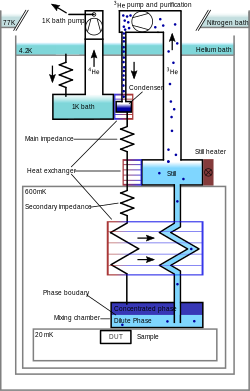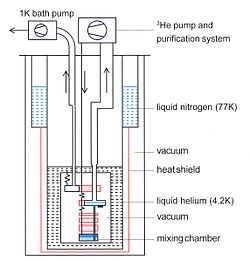
Back ثلاجة التمديد Arabic Mischungskryostat German یخچال رقیقسازی Persian Réfrigérateur à dilution French Refrigeratore a diluizione Italian 3He-4He希釈冷凍法 Japanese 희석냉동기 Korean Refrigerador de diluição Portuguese Рефрижератор растворения Russian Рефрижератор розчинення Ukrainian







A 3He/4He dilution refrigerator is a cryogenic device that provides continuous cooling to temperatures as low as 2 mK, with no moving parts in the low-temperature region.[1][2] The cooling power is provided by the heat of mixing of the helium-3 and helium-4 isotopes.
The dilution refrigerator was first proposed by Heinz London in the early 1950s, and was experimentally realized in 1964 in the Kamerlingh Onnes Laboratorium at Leiden University.[3] The field of dilution refrigeration is reviewed by Zu et al.[4]
- ^ Lounasmaa, O.V. (1974). Experimental Principles and Methods Below 1 K. London: Academic Press. p. 316. ISBN 978-0-12-455950-9.
- ^ Pobell, Frank (2007). Matter and Methods at Low Temperatures. Berlin: Springer-Verlag. p. 461. ISBN 978-3-540-46360-3.
- ^ Das, P.; Ouboter, R. B.; Taconis, K. W. (1965). "A Realization of a London-Clarke-Mendoza Type Refrigerator". Low Temperature Physics LT9. p. 1253. doi:10.1007/978-1-4899-6443-4_133. ISBN 978-1-4899-6217-1.
- ^ Zu, H.; Dai, W.; de Waele, A.T.A.M. (2022). "Development of dilution refrigerators – A review". Cryogenics. 121. doi:10.1016/j.cryogenics.2021.103390. ISSN 0011-2275. S2CID 244005391.
© MMXXIII Rich X Search. We shall prevail. All rights reserved. Rich X Search